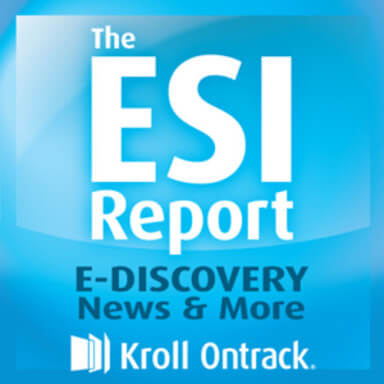Andrea Gibson is the Director of Product for Discovery Solutions at Kroll Ontrack, specifically working on the...
Brian Calla is a member at Eckert Seamans in Pittsburgh, PA. He concentrates his practice in general...
Michele Lange is Kroll Ontrack’s Director of Thought and Leadership and a nationally recognized e-discovery expert. Kroll...
| Published: | December 29, 2014 |
| Podcast: | ESI Report |
| Category: | e-Discovery , Legal Technology , Practice Management |
There has been a rapid growth in electronically stored information that is potentially useful for e-discovery in litigation. Because more data storage means higher costs, organizations are searching for new ways to store their information efficiently and cost effectively while at the same time not limiting access throughout discovery, a process which can sometimes last for months or years. It is important for litigators and large companies to understand what their options are for data storage and hosting cost flexibility. A process called “nearlining” provides a relatively simple solution to this problem of expensive data storage.
On this episode of the ESI Report, host Michele Lange interviews discovery product director Andrea Gibson and civil litigator Brian Calla about data storage costs, the nearlining process, the formatting of data storage, and other innovations in document review. Gibson explains that data access is not necessarily to all data, but to the appropriate data for any point in time, which can change throughout the life of an investigation, regulatory review, or litigation. The challenge lies in keeping volume of information reduced while maintaining access to what’s important. Nearlining, she says, is a capability by which you can store data that isn’t currently necessary, making the active data footprint smaller and greatly reducing electronic information storage costs. Calla, who often deals with e-discovery, discusses how nearlining works with his clients’ needs. Often, they wish to collect too much data initially. In this case he uses predictive coding to weed out unnecessary data and nearlines it for potential later need. When a project or review is finished, he will nearline all documents that are coded not responsive. Gibson and Calla finish by discussing other data storage innovations they each use to reduce costs including reformatting, predictive coding, and automatic redactions.
Brian Calla is a member at Eckert Seamans in Pittsburgh, PA. He concentrates his practice in general civil litigation with a particular emphasis on e-discovery, mass tort litigation and products liability. Calla serves as an Electronic Discovery Special Masters (EDSM) panel member for the U.S. District Court for the Western District of Pennsylvania.
Andrea Gibson is the Director of Product for Discovery Solutions at Kroll Ontrack, specifically working on the ediscovery.com Review product line. She has more than 10 years of direct experience as a litigator and legal consultant.

|
ESI Report |
ESI Report, brought to you by Kroll Ontrack, covers the latest e-discovery trends and developments.